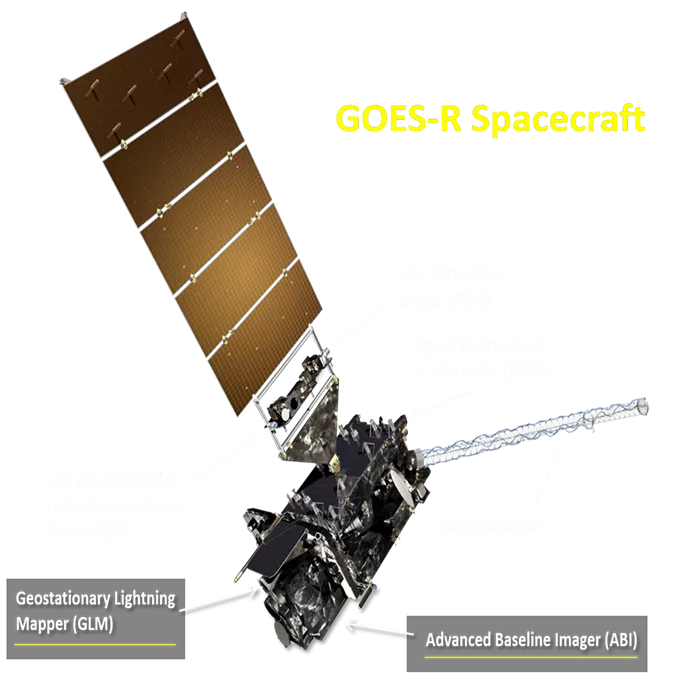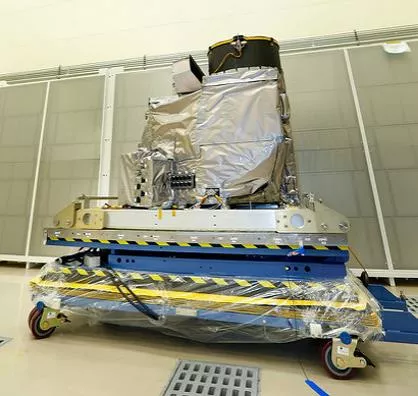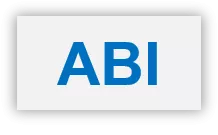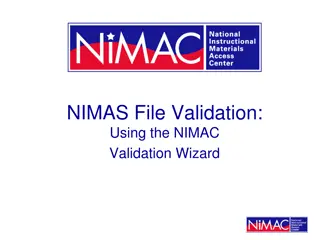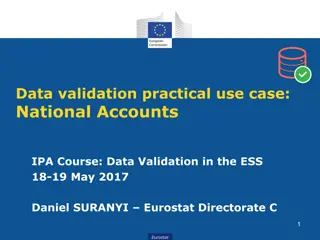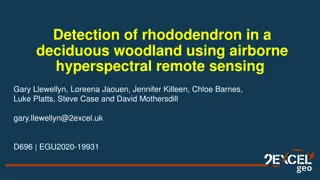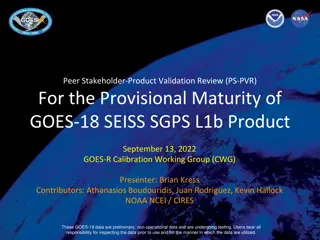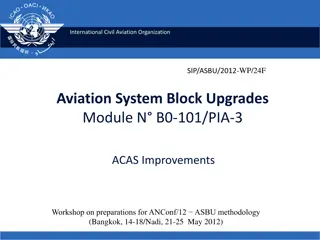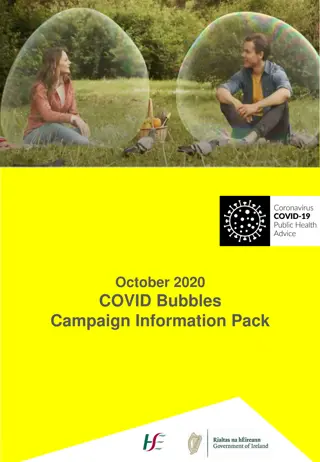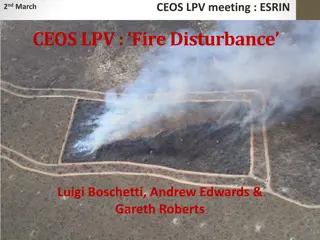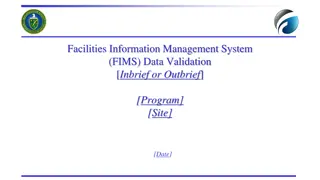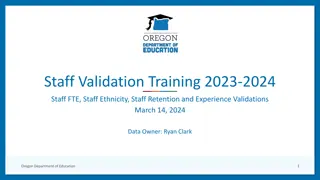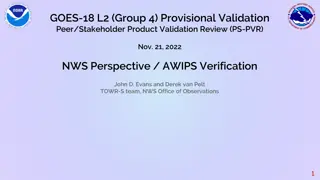GOES-R Airborne Science Validation Field Campaign Overview
The GOES-R field campaign aimed to validate ABI and GLM products post-launch by coordinating the high-altitude NASA ER-2 aircraft with ground-based reference data over various Earth targets from March 21 to May 17, 2017. The primary objective was the independent validation of ABI spectral radiance observations, with specific performance metrics set for reflective solar bands and thermal emissive bands. The campaign involved various SI traceable airborne instruments and instruments based on the ER-2 aircraft, culminating in fully coordinated validation flights of ABI detectors. Independent absolute validation of ABI reflective solar bands against AVIRISng showed band average results to ensure accuracy of ABI observations.
Download Presentation

Please find below an Image/Link to download the presentation.
The content on the website is provided AS IS for your information and personal use only. It may not be sold, licensed, or shared on other websites without obtaining consent from the author.If you encounter any issues during the download, it is possible that the publisher has removed the file from their server.
You are allowed to download the files provided on this website for personal or commercial use, subject to the condition that they are used lawfully. All files are the property of their respective owners.
The content on the website is provided AS IS for your information and personal use only. It may not be sold, licensed, or shared on other websites without obtaining consent from the author.
E N D
Presentation Transcript
GOES-R Airborne Science Validation Field Campaign Overview Goal of the GOES-R field campaign was to support post-launch validation of ABI & GLM L1b & L2+ products: GOES-R Spacecraft High-altitude NASA ER-2 platform coordinated with ground based reference data over several Earth targets: March 21 May 17, 2017 Primary objective: all detector independent validation of ABI spectral radiance observations Validation analysis coordinated through an ABI field campaign analysis working group (Program Science, CWG, Univ. Wisc., JPL, NASA/GSFC) ABI Performance Metrics: Reflective Solar Bands (RSB) 5 % radiometric uncertainty Thermal Emissive Bands (TEB) 1 K radiometric uncertainty 1
ABI Primary Validation with SI Traceable Airborne Instruments AVIRISng S-HIS ABI Instrument Spectral Range Spatial Resolution Swath Width Radiometric Uncertainty 3 % AVIRISng (JPL) 0.38 2.51 m (480 bands) 20 m ~11 km (SI Traceability to NIST via FEL Lamp) <5 % ABI Reflective Solar Bands 0.47 2.25 m (6 bands) 500 m, 1 km, or 2 km 500 km (SI Traceability NIST calibrated transfer sphere & FEL Lamp) 0.04 K S-HIS 3.33 17.24 m (4607 channels) (k=1: over ABI bands and scene temperatures of interest) (SI Traceability NIST TXR) 2 km 40 km (Univ. of Wisc.) ABI Thermal Emissive Bands 3.9 13.3 m (10 bands) <1 k 2 km 500 km (SI Traceability NIST TXR)
GOES-R Field Campaign ER-2 Based Instruments AVIRIS-NG LIP LIP FEGS INMARSAT EXRAD CRS S-HIS GCAS CPL LIP 3
ABI Primary Validation Flights Fully coordinated: 90 minutes of continuous ABI North-South Scan (NSS) collections concurrent with the ER-2 aircraft based reference sensors over ideal Earth targets Ocean Mission Desert Mission ABI Primary RSB Validation: All ABI Detectors used in the Validation March 28, 2017 ABI Primary TEB Validation: All ABI Detectors used in the Validation April 13, 2017 ABI Ch. 6 ABI Ch. 5 All ABI TEB: ABI Ch. 7-16 ABI Ch. 2 & 3 ABI Ch. 1
Independent Absolute Validation of ABI Reflective Solar Bands (RSB) All Detectors ABI NSS vs AVIRISng Comparison (March 28, 2017) Band Average Results ABI RSB SI traceability was independently validated (all detectors) ABI Ch 2 showed larger biases than expected (consistent with previous findings) PERCENT DIFFERENCE AVIRISng VS ABI 7.02 PERCENT DIFFERENCE (ABI - AVIRISng) / AVIRISng * 100 3.16 1.35 0.68 ABI Ch 6 1 2 3 4 5 ABI Ch 1 ABI Ch 2 ABI Ch 3 ABI Ch 5 -0.80 ABI BAND 5
ABI Independent Detector-Level Validation Results: Sonoran Desert March 28, 2017 ABI Channel 1 ABI Channel 2 ABI Channel 3 ABI Channel 5 ABI Channel 6 ABI detector-level performance showed inter-channel variability 3 % (k=1) for each channel Ch 5 & Ch 6 demonstrate some systematic effects to be further investigated 6
ABI & VIIRS Intercomparison Using AVIRISng as a Reference March 23, 2017 Sonoran Desert Mission ER-2 & S-NPP coincident & collocated nadir overpass of the Sonoran Desert: Collection provided validation of all NOAA next generation imagers on the same flight (VIIRS - AVIRISng) / AVIRISng * 100 3 2 1 0 1 2 3 4 5 6 7 8 9 10 11 M1 M2 M3 M4 M5 M7 M8 M10 M11 Bias -1 -2 -3 -4 -5 -6 VIIRS Bands (M1 to M11) 7
ABI & VIIRS Inter-comparison Using AVIRISng as Reference VIIRS ABI Radiance (W/[m2-sr- m]) ABI bias relative to S-NPP VIIRS Reflectance VIIRS Data Spectral Bias using AVIRIS (%) ABI Bands ( m) Observed Bias (%) Actual Bias (%) 1 (0.450 - 0.490) 4.63 0.12 4.51 Bias= (ABI bias relative to AVIRIS) (VIIRS bias relative to AVIRIS) 2 (0.590 - 0.690) 9.65 -0.44 10.09 3 (0.846 - 0.885) 2.95 -0.33 3.28 5 (1.580 - 1.640) 1.37 -0.52 1.89 6 (2.225 - 2.275) -3.35 5.38 -8.73 AVIRISng is used as a reference standard to compare ABI with VIIRS. Spectral differences between ABI & VIIRS are taken into account using AVIRISng radiance spectra. Comparison results consistent with biases previously reported between ABI & S-NPP/VIIRS: Investigating larger than expected bias in band 6 may be related to GEO-LEO collocation pixels used 8
Preliminary Independent Absolute Validation of ABI Thermal Emissive Bands (TEB) ABI NSS Data vs S-HIS Comparison (April 13, 2017) Band Average Results GOES-R Field Campaign ER-2 Based Instruments ABI NSS BRIGHTNESS TEMPERATURE DIFF: ABI - S-HIS [K] (RELATIVE TO A 300 K BB) 3.90 m 6.19 m 6.95 m 7.34 m 8.50 m 9.61 m 10.35 m 11.20 m 12.30 m 13.30 m BRIGHTNESS TEMP. DIFFERENCE (ABI - S-HIS [K] 0.24 0.06 -0.04 -0.11 -0.21 -0.50 -0.58 -0.59 ABI TEB SI traceability independently validated (obs vs obs) with biases 1 K Analysis does NOT YET account for atmospheric contributions above the aircraft (20 km to TOA) which should reduce biases in most channels -1.22 CH7 CH8 CH9 CH10 CH11 CH12 CH13 CH14 CH15 CH16 ABI BAND 9
ABI Independent Detector-Level Validation Results: Gulf of Mexico April 13, 2017 - Brightness Temperature Difference [K] (ABI S-HIS) Rel. 300 K BB ABI Ch 7 NSS Brightness Temperature Diff: ABI - S-HIS [K] (Rel. 300 K BB) ABI Channel 7 ABI Ch8 NSS Brightness Temperature Diff: ABI - S-HIS [K] (Rel. 300 K BB) ABI Channel 8 ABI Ch 9 NSS Brightness Temperature Diff: ABI - S-HIS [K] (Rel. 300 K BB) ABI Channel 9 ABI Ch10 NSS Brightness Temperature Diff: ABI - S-HIS [K] (Rel. 300 K BB) ABI Channel 10 0.5 0.5 0.5 0.5 BT Diff. ABI S-HIS [K] 0 0 0 0 BT Difference (ABI - S-HIS [K] BT Difference (ABI - S-HIS [K] BT Difference (ABI - S-HIS [K] BT Difference (ABI - S-HIS [K] -0.5 -0.5 -0.5 -0.5 -1 -1 -1 -1 -1.5 -1.5 -1.5 -1.5 -2 -2 -2 -2 0 30 60 90 120 150 180 210 240 270 300 330 0 30 60 90 120 150 180 210 240 270 300 330 0 30 60 90 120 150 180 210 240 270 300 330 0 30 60 90 120 150 180 210 240 270 300 330 Detector # Detector # Detector # Detector # ABI Channel 11 ABI Channel 12 ABI Channel 13 ABI Channel 14 ABI Ch11 NSS Brightness Temperature Diff: ABI - S-HIS [K] (Rel. 300 K BB) ABI Ch12 NSS Brightness Temperature Diff: ABI - S-HIS [K] (Rel. 300 K BB) ABI Ch13 NSS Brightness Temperature Diff: ABI - S-HIS [K] (Rel. 300 K BB) ABI Ch14 NSS Brightness Temperature Diff: ABI - S-HIS [K] (Rel. 300 K BB) 0.5 -7 0.5 0.5 BT Diff. ABI S-HIS [K] Ozone Ch. Atm. above the aircraft not yet accounted for 0 0 0 -7.5 BT Difference (ABI - S-HIS [K] BT Difference (ABI - S-HIS [K] BT Difference (ABI - S-HIS [K] BT Difference (ABI - S-HIS [K] -0.5 -0.5 -8 -0.5 -1 -1 -8.5 -1 -1.5 -1.5 -9 -1.5 -2 -2 -9.5 -2 0 50 100 150 200 250 300 350 400 0 50 100 150 200 250 300 350 400 0 30 60 90 120 150 180 210 240 270 300 330 0 30 60 90 120 150 180 210 240 270 300 330 Detector # Detector # Detector # Detector # ABI Channel 15 ABI Channel 16 ABI Ch15 NSS Brightness Temperature Diff: ABI - S-HIS [K] (Rel. 300 K BB) ABI Ch16 NSS Brightness Temperature Diff: ABI - S-HIS [K] (Rel. 300 K BB) ABI detector-level inter-channel performance was found to be band dependent with some systematic effects to be further investigated in some channels 0.5 0.5 BT Diff. ABI S-HIS [K] 0 0 BT Difference (ABI - S-HIS [K] BT Difference (ABI - S-HIS [K] -0.5 -0.5 -1 -1 -1.5 -1.5 -2 -2 0 50 100 150 200 250 300 350 400 0 50 100 150 200 250 300 350 400 10 Detector # Detector #
Independent Validation Summary GOES-R ABI detector-level SI traceability has been independently validated post-launch (AVIRISng & S-HIS as references): Reflective Solar Bands: bias to reference 5 % (except ABI Ch.2: ~7% bias) Thermal Emissive Bands: bias to reference 1 K Deep dive analysis is on-going by multiple teams Open data access policy: Data portal - https://goes-r.nsstc.nasa.gov/home/ Long-term archive at NCEI/CLASS Lessons learned: Demonstrated the utility of ABI North-South Scans (NSS) to characterize & validate on-orbit detector-level performance Recommend that GEO-LEO validation inter-comparison results include a histogram of collocation pixels used (i.e. which detectors used) to track detector-level impacts to ensure traceability These collections & data sets are unprecedented in geostationary Earth observation & mark a major achievement towards the post-validation of the GOES-R series instruments 11









